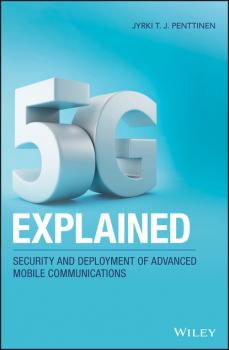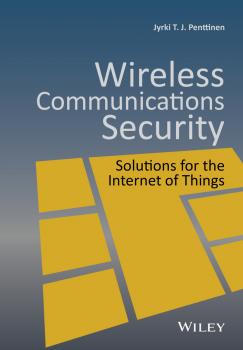ТОП просматриваемых книг сайта:
Jyrki T. J. Penttinen
Список книг автора Jyrki T. J. PenttinenАннотация
Аннотация
This book describes the current and most probable future wireless security solutions. The focus is on the technical discussion of existing systems and new trends like Internet of Things (IoT). It also discusses existing and potential security threats, presents methods for protecting systems, operators and end-users, describes security systems attack types and the new dangers in the ever-evolving Internet. The book functions as a practical guide describing the evolvement of the wireless environment, and how to ensure the fluent continuum of the new functionalities, whilst minimizing the potential risks in network security.
Аннотация
Describing the essential aspects that need to be considered during the deployment and operational phases of 3GPP LTE/SAE networks, this book gives a complete picture of LTE systems, as well as providing many examples from operational networks. It demystifies the structure, functioning, planning and measurements of both the radio and core aspects of the evolved 3G system. The content includes an overview of the LTE/SAE environment, architectural and functional descriptions of the radio and core network, functionality of the LTE applications, international roaming principles, security solutions and network measurement methods. In addition, this book gives essential guidelines and recommendations about the transition from earlier mobile communications systems towards the LTE/SAE era and the next generation of LTE, LTE-Advanced. The book is especially suitable for the operators that face new challenges in the planning and deployment phases of LTE/SAE, and is also useful for network vendors, service providers, telecommunications consultancy companies and technical institutes as it provides practical information about the realities of the system. Presents the complete end-to-end planning and measurement guidelines for the realistic deployment of networks Explains the essential and realistic aspects of commercial LTE systems as well as the future possibilities An essential tool during the development of transition strategies from other network solutions towards LTE/SAE Contains real-world case studies and examples to help readers understand the practical side of the system
The LTE-Advanced Deployment Handbook. The Planning Guidelines for the Fourth Generation Networks - Jyrki T. J. Penttinen
Аннотация
LTE-Advanced is the new Global standard which is expected to create a foundation for the future wireless broadband services. The standard incorporates all the latest technologies recently developed in the field of wireless communications. Presented in a modular style, the book provides an introductory description for beginners as well as practical guidelines for telecom specialists. It contains an introductory module that is suitable for the initial studies of the technology based on the 3GPPRelease 10, 11 and beyond of LTE and SAE. The latter part of the book is suitable for experienced professionals who will benefit from the practical descriptions of the physical core and radio network planning, end-to-end performance measurements, physical network construction and optimization of the system. The focus of the book is in the functioning, planning, construction, measurements and optimization of the radio and core networks of the Release 10 and beyond of the 3GPP LTE and SAE standards. It looks at the practical description of the Advanced version of the LTE/SAE, how to de-mystify the LTE-Advanced functionality and planning, and how to carry out practical measurements of the system. In general, the book describes «how-to-do-it» for the 4G system which is compliant with the ITU-R requirements.
The Telecommunications Handbook. Engineering Guidelines for Fixed, Mobile and Satellite Systems - Jyrki T. J. Penttinen
Аннотация
This practical handbook and reference provides a complete understanding of the telecommunications field supported by descriptions and case examples throughout Taking a practical approach, The Telecommunications Handbook examines the principles and details of all of the major and modern telecommunications systems currently available to industry and to end-users. It gives essential information about usage, architectures, functioning, planning, construction, measurements and optimisation. The structure of the book is modular, giving both overall descriptions of the architectures and functionality of typical use cases, as well as deeper and practical guidelines for telecom professionals. The focus of the book is on current and future networks, and the most up-to-date functionalities of each network are described in sufficient detail for deployment purposes. The contents include an introduction to each technology, its evolution path, feasibility and utilization, solution and network architecture, and technical functioning of the systems (signalling, coding, different modes for channel delivery and security of core and radio system). The planning of the core and radio networks (system-specific field test measurement guidelines, hands-on network planning advices and suggestions for the parameter adjustments) and future systems are also described. Each chapter covers aspects individually for easy reference, including approaches such as: functional blocks, protocol layers, hardware and software, planning, optimization, use cases, challenges, solutions to potential problems Provides very practical detail on the planning and operation of networks to enable readers to apply the content in real-world deployments Bridges the gap between the communications in the academic context and the practical knowledge and skills needed to work in the telecommunications industry Section divisions include: General theory; Fixed telecommunications; Mobile communications; Space communications; Other and special communications; and Planning and management of telecommunication networks Covers new commercial and enhanced systems deployed, such as IPv6 based networks, LTE-Advanced and GALILEO An essential reference for Technical personnel at telecom operators; equipment and terminal manufacturers; Engineers working for network operators.





